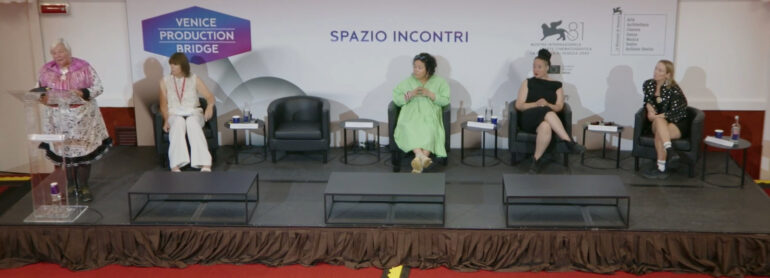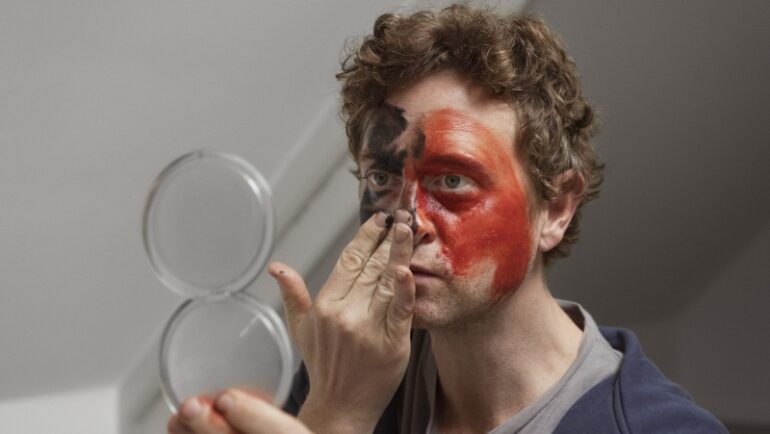WRITTEN BY: Davide Abbatescianni
At the Venice Production Bridge, the panellists discussed the rise of the Circumpolar Screen Industry, focusing on narrative sovereignty, diverse storytelling and overcoming funding challenges.
On 2 September, Hotel Excelsior’s Spazio Incontri hosted a panel titled “The Rise of the Circumpolar Screen Industry: International Models, Collaboration, and Innovation in the Far North”. The event was part of the Venice Production Bridge, which ran from 29 August to 3 September.
After opening remarks by Venice Production Bridge Head Pascal Diot and the Ambassador of Canada to Italy Elissa Golberg, the mic was handed to Kerry Swanson, CEO of the Indigenous Screen Office (ISO), who also served as the panel’s moderator.
Swanson introduced the other guests on stage: Film Commissioner and CEO of the Arctic Indigenous Film Fund (AIFF) Liisa Holmberg; artist and filmmaker Laakkuluk Williamson Bathory; singer and filmmaker Elle Márjá Eira; and producer and writer-director Pipaluk Kreutzmann Jørgensen.
Swanson began by discussing the role of the ISO. Based in Canada, the organisation aims “to support Indigenous companies, communities, and individuals in sharing their diverse stories and perspectives across all screen platforms”. One of its core goals is to pursue “narrative sovereignty” by advocating for control and ownership over Indigenous storytelling, and supporting legislation for Indigenous content, languages, and advocacy. To date, the ISO has disbursed $11.9 million CAD and supported the production of notable Indigenous films such as Kaniehtiio Horn’s comedy thriller Seeds and Jennifer Wickham, Brenda Michell and Michael Toledano’s Yintah.
Next, Holmberg discussed the AIFF’s inception in 2018 and presented a world map illustrating the distribution of Indigenous peoples. Currently, there are 400,000 Indigenous people in the Arctic, making up 10% of its population.
“Thirty years ago, we represented 30% of the population. Many people have moved into our area. We’re more than 100 different ethnic groups, speaking around 200 languages. Even the Sámi speak ten different languages. Our stories include our own mythologies, heroes, power struggles, and love stories. What unites us is our bond with the land,” said Holmberg.
“We’ve seen growing interest in our stories from festivals like Cannes, Venice, Toronto, and Berlinale. But it’s not enough. We must ensure these filmmakers have the resources to tell their stories authentically, without compromise, and with full support. Our fund focuses on this goal, working across and beyond borders. We’re not just one story; we want to emphasise diversity,” she continued.
Holmberg outlined three “pillars” for achieving this goal: sustainability, authenticity, and community engagement. In particular, AIFF aims to build a strong film community “up in the north”, so that people don’t have to constantly travel between Canada and Europe.
She also addressed the scepticism often encountered regarding the reach of Indigenous stories: “I think there’s more than enough audience. Last year, Elle Márjá Eira’s Stolen (Stöld) attracted around 17 million viewers, and Isabella Eklöf’s Kalak reached 30 million. There is significant interest in our stories; we no longer need to justify their value.”
Holmberg praised the efforts of the ISO in Canada and the International Sámi Film Institute: “These positive models are already in place. Ultimately, I believe our stories are powerful and our perspectives are necessary. With adequate support, we can make a global impact, which is crucial in these times.”
Kreutzmann Jørgensen discussed her work with two companies based in Nuuk, Greenland’s capital. She serves as a writer-director for one and co-founded the other, which operates as a service producer managing productions and co-productions with Denmark and other international partners.
One of her notable projects is Ivalu (2022), an Oscar-nominated short film co-directed with Anders Walter, based on a graphic novel by Lars Horneman and Morten Dürr.
Williamson Bathory, who has both Greenlandic and Nunavut heritage and is currently based in Canada, spoke proudly of her background. She is a multidisciplinary artist active in VR films, theatre, and art galleries. “Being a multidisciplinary artist is common among Inuit. We don’t want to be confined to one particular way of doing things; we are 'improvisational' from a young age,” she said.
Eira emphasised the importance of her heritage and her home: “I live in a small village of 3,000 people. My family consists of reindeer herders, and I am a reindeer herder myself. I want to stay there because it is where my family, language, and land are.” For her, art is about “staying home” and “experiencing inspiring silences”.
Swanson asked the panellists how Indigenous filmmakers can maintain control over their stories when working with large foreign productions. Kreutzmann Jørgensen highlighted the importance of having a say during the development stage (by hiring local writers) or at least during production.
“Netflix came to my village with a Sámi story by a Sámi author and was looking for a Sámi director. It was crucial to film in the north, with a real herding family. The story follows a girl growing up in a village facing hatred and discrimination from locals who kill her reindeer. This is still happening there. We filmed in deep snow, with temperatures of -40°C, no toilets, no electricity, far from civilisation. We used snowmobiles. It was important to involve as many Sámi people as possible, who understand the environment. However, there aren’t enough professional filmmakers, so it’s necessary to teach non-Sámi people about the culture and how to handle the environment,” Eira added.
Swanson also asked the panellists how they adjust to a funding context that is primarily national and doesn’t consider the transnational context of Indigenous peoples.
Holmberg responded: “We are still under the Kingdom of Denmark’s rule. We have to co-produce with Denmark to finance a film, because we lack the resources in Greenland to do so independently. We want to open a discussion about this. Canada is working towards a fairer model, but here we’re still figuring it out. It’s very frustrating.”
Williamson Bathory and Eira agreed with Holmberg, noting the influence of Danish and Canadian “colonial gaze” and the difficulty of moving within their regions, let alone travelling internationally.
Kreutzmann Jørgensen suggested that Indigenous filmmakers be more assertive. “Sometimes it’s not just about being Indigenous, but also about being a woman. I feel secure in my own voice now, but we should ask ourselves what kinds of projects we are working on.”
“The world is beginning to discover Indigenous people and their stories, and there are still many untold ones,” Eira concluded.

